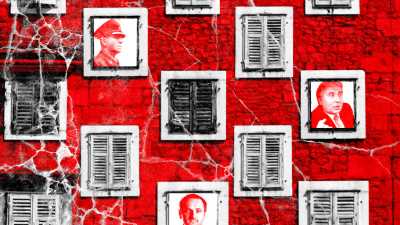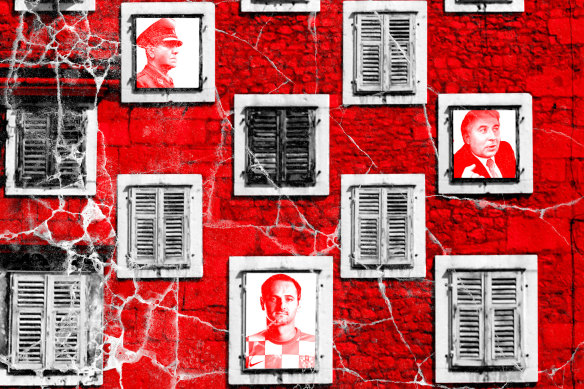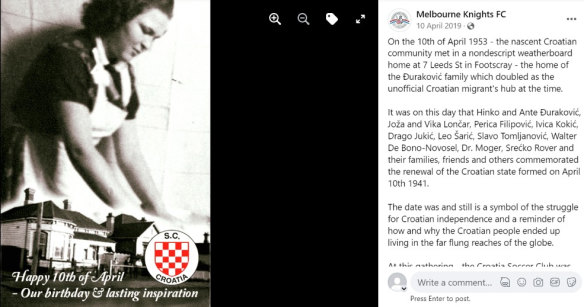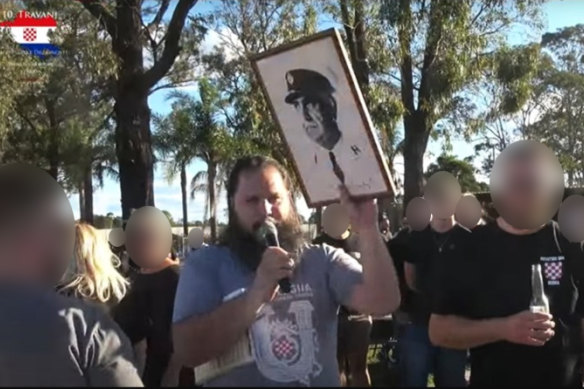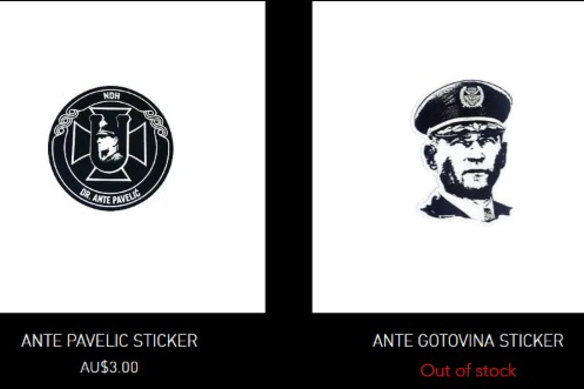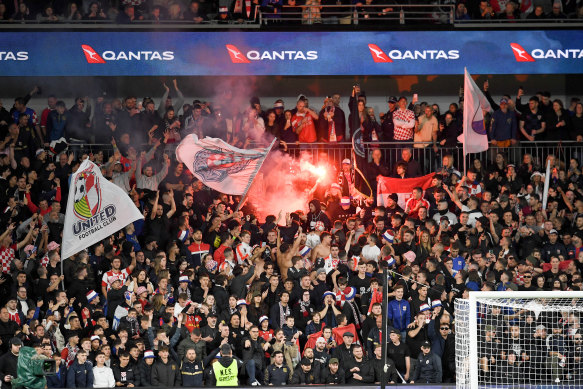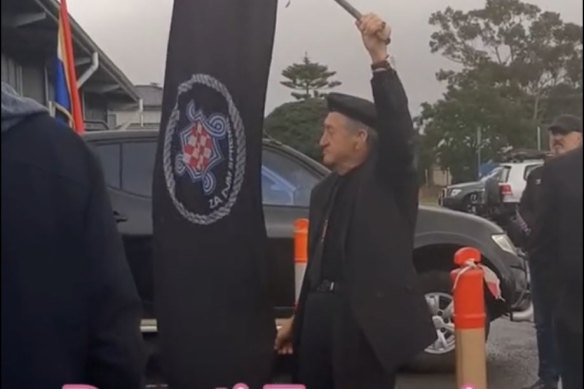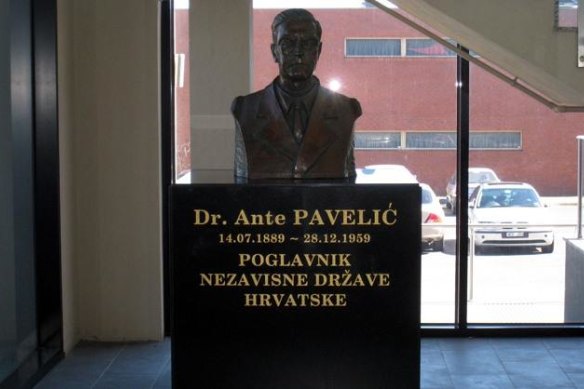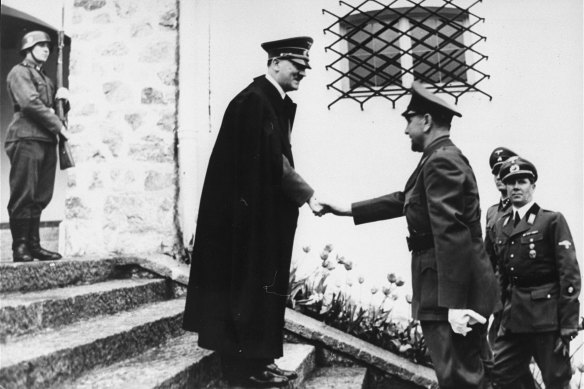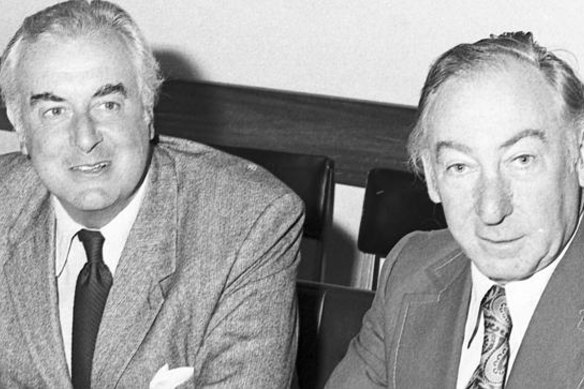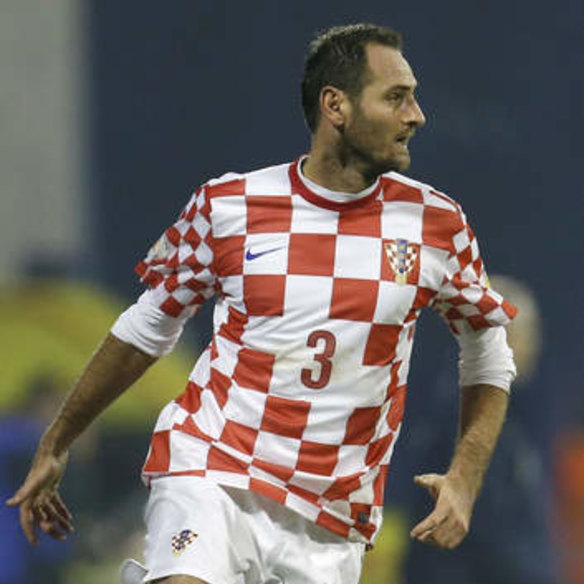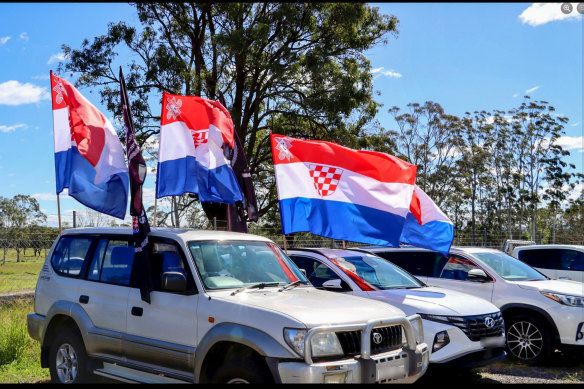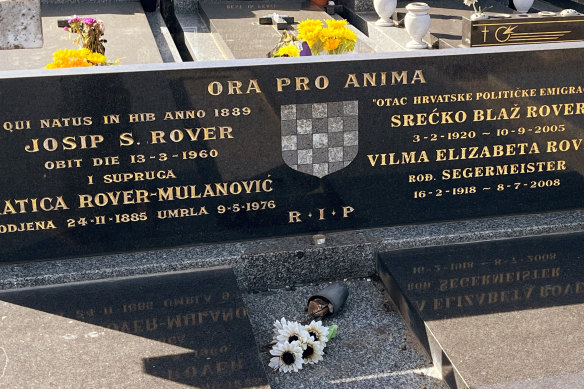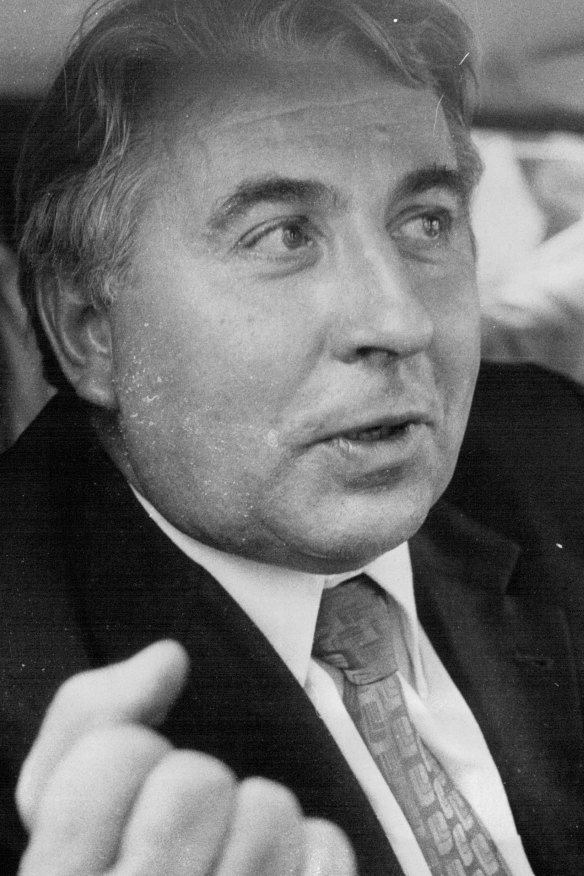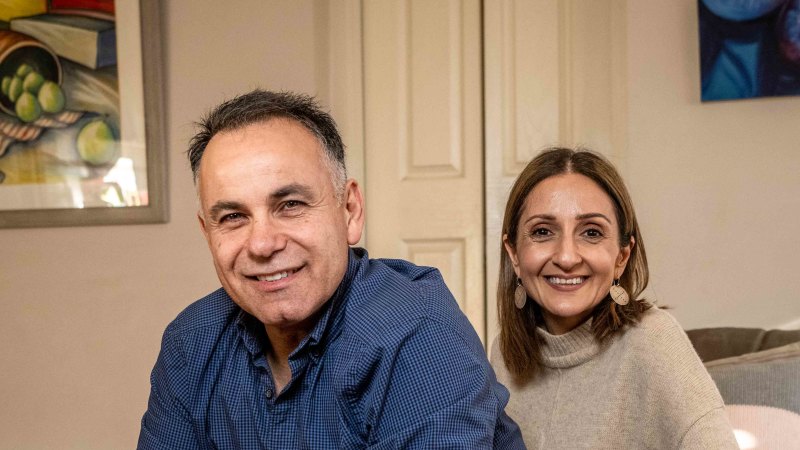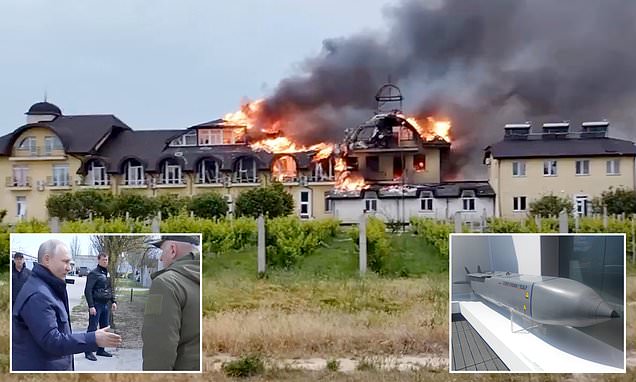By Ben Schneiders and Simone Fox Koob
Australia’s Croatian migrant community has a chequered history.Credit: Illustration by Richard Giliberto
Save articles for later
Add articles to your saved list and come back to them any time.
When a small group of Croatian emigres met in 1953 in a humble weatherboard house in Footscray, a world away from the strife of a destroyed Europe, they formed a soccer club that would help transform the sport and twice be champions of Australia.
But from the start, that meeting in inner Melbourne was not just about soccer.
That small group of migrants deliberately chose to start their club on April 10. In 1953, that was the 12th anniversary of the creation of a Nazi-backed puppet state in Croatia. That state, ruled by a movement called the Ustasha, on conservative estimates killed 500,000 Serbs, Jews and Romani people during the war.
Celebration of the creation of the Nazi-backed state of Croatia 1941-1945 by the Melbourne Knights soccer club from a Facebook post.
At the meeting to create the club, which later became the Melbourne Knights, was Srecko Rover, a man who would play a pivotal role in the emerging Croatian community in Australia.
He was a man with a dark history. During the war, Rover was part of the Ustasha elite and, as journalist Mark Aarons later wrote, had overseen mobile execution squads.
On Hitler’s birthday in 1944, Ustasha dictator Ante Pavelic awarded Rover the prestigious Small Silver Medal for his role in battles against “renegades”. Rover denied detailed witness accounts of crimes and died in 2005.
The story of the Melbourne Knights is a microcosm of the tensions within a large migrant community, Croatian Australians, over their history.
It presents uncomfortable questions about the mainstreaming of far-right symbolism – ASIO has identified the rise of political extremism in general as a significant concern – and how to deal with the past in a multicultural country where many experience direct or intergenerational trauma from genocide.
Many of the experts interviewed for this investigation said views in sections of the Croatian diaspora in Australia were much more extreme than in modern-day Croatia, with displays of support for fascism more open and mainstream.
Celebration of the creation of the Nazi-backed state of Croatia in western Sydney at the Croatian Club Bosna this year. Club president Adam Glavas is holding a portrait of World War II dictator Ante Pavelic.
It is clear that a minority of Croatians in Australia still choose to celebrate Croatia’s fascist past. They range from young people performing stiff-arm salutes at the soccer, to people controlling some of the community’s most important institutions – its community centres and soccer clubs. Ustasha flags were also observed at anti-lockdown protests during the pandemic.
Flags, clothing and key rings decorated with the symbols and phrases of the Ustasha – including portraits of dictator Ante Pavelic – are being sold from Sydney, with the content shared and celebrated across social media.
A sticker on sale from an Australian website of dictator Ante Pavelic.
The open celebration of that past is a source of tension with Serbian and Jewish Australians.
Croatia’s ambassador to Australia, Betty Pavelich, told this masthead there was no place for the “glorification of totalitarian regimes, extremism or intolerance”.
“We firmly believe that it behoves us all to ensure that disinformation, glorification and the mainstreaming of criminal, totalitarian ideologies, their symbols and movements, do not take root in modern societies,” she said.
Pavelich added it was important not to malign “law-abiding and respectful communities, based on the unacceptable views and behaviour of small groups of individuals”.
Croatia’s Ambassador to Australia, Betty Pavelich.
At the Knights, which hope to enter soccer’s national second division next year, there is no public disavowal that one of their founders was an accused war criminal. Rather his role is celebrated, as is the Ustasha-linked date of the club’s birth, April 10.
“It was these people that began a story, tradition and movement that we uphold today,” the club proclaimed via social media on the day in 2019. “The date was and still is a symbol of the struggle for Croatian independence and a reminder of how and why the Croatian people ended up living in the far-flung reaches of the globe.”
Symbols and salutes
On an October night last year, among 16,000 rowdy soccer fans gathered at Sydney’s CommBank Stadium to watch the Australia Cup final, a small group began to chant.
“Za dom, spremni,” came the cries from some supporters of Sydney United 58, formerly known as Sydney Croatia, another storied club in Australia’s soccer history.
The chant means “for homeland, ready”, and it was the catch-cry of the Ustasha. In modern-day, democratic Croatia, the chant is considered an offence against public order for inciting hatred and can attract fines, with even stricter penalties implemented in April this year.
Sydney United fans light a flare during the Australia Cup match between Sydney United FC and Macarthur FC at CommBank Stadium. Credit: Getty
The behaviour was quickly condemned. Football Australia issued life bans to two spectators and Sydney United was slapped with sanctions, including a $15,000 fine. Three fans were also later charged by NSW Police for knowingly displaying a Nazi symbol without excuse, and have since pleaded not guilty.
It was shocking to mainstream soccer fans. Criticism was swift from prominent figures and commentators including Craig Foster. Former Socceroo Mark Bosnich, who is of Croatian background, said Nazi salutes and iconography needed to be removed from the game so as not to tar the entire Croatian community with the same brush.
But an examination of the activities and online content generated by several major sporting and cultural clubs in Australia’s Croatian community shows this shouldn’t have come as a surprise.
A number of major clubs annually celebrate April 10 publicly sharing pictures of their events and celebrations.
In 2023, Croatia is a member of the European Union and has a different day to celebrate, as Pavelich notes, with its constitution “rooted in our commitment to democratic values and our rejection of fascism and communism”. On May 30, Croatia celebrated 33 years of statehood, while on July 1 it will be a decade since it joined the EU.
But at the Melbourne Knights this year, six men were filmed on April 10 doing stiff-armed salutes as they sang a song extolling the Ustasha.
In a separate video, a group raised a Croatian flag at the Melbourne Knights in Sunshine, in Melbourne’s west, to celebrate the April 10 anniversary – known as Deseti Travanj.
The flag was not the modern-day flag of democratic Croatia, which includes a crown above the distinctive red and white shield. Rather it uses an older flag with a complex history that has often been used by diaspora communities.
The main speaker at the flag raising said: “This day [April 10] is unforgettable,” according to a professional translation. “Croats will continue to keep this day in memory.”
One of the men in attendance was dressed in black while flying a Croatian military flag with “za dom, spremni” – the Ustasha salute – printed on it.
Celebration of the creation of the Nazi-backed state of Croatia 1941-1945 at the Melbourne Knights soccer club in Sunshine in Melbourne on April 10 this year.
The president of the Knights, Pave Jusup, is pictured in front of an Ustasha flag on two of his social media accounts. An amateur soccer team in Melbourne, St Albans Vukovar, until several years ago had the Ustasha’s U symbol prominently on the front of its playing shirts.
The Jewish Community Council of Victoria has called on sporting clubs and leagues to implement codes of conduct and uniform rules that prevent the display of fascist symbols at matches. “For those supporters or clubs that do not comply, we would urge the strictest sanctions,” said council president Daniel Aghion, KC.
There are different approaches across Australia. NSW has the broadest laws allowing courts the discretion to define what constitutes a Nazi symbol. Laws in Victoria – and ones to be introduced to federal parliament this week – are narrower in proscribing a limited number of Nazi hate symbols.
Executive Council of Australian Jewry co-chief executive Peter Wertheim has said any banning legislation must be flexible enough to accommodate the constant evolution of new hate symbols by neo-Nazi groups “as well as the symbols of political movements, such as the Ustasha movement, that were historically allied to the Nazi regime in Germany”.
Arrival in Australia
It’s hard to miss the imposing stone bust of Ante Pavelic in the lobby of Footscray’s Croatian Club in Melbourne.
As the head of the Ustasha, Pavelic was installed by Nazi Germany and its Axis allies as dictator of the puppet state known as Nezavisna Država Hrvatska (the NDH) – the Independent State of Croatia.
For decades the club itself was named after Pavelic. Even now, one of its function rooms is named after a convicted war criminal, former general Mirko Norac (another function room was named after a general convicted of war crimes whose conviction was overturned on appeal). The club was approached for comment.
Bust of Ustasha leader Ante Pavelic in the Croatian Club in Footscray
The Ustasha regime was, until the 1990s, the only modern example of Croatian independence – a long sought-after goal of many Croats.
Its legacy included laws persecuting Serbs, Jews and Roma, stripping them of their rights and establishing concentration camps, including one for children. That ethnic cleansing, done with the agreement of Nazi Germany, is considered by scholars to constitute genocide.
The most significant concentration camp was Jasenovac. Figures differ about how many were killed there, but the official memorial site has identified more than 83,000 by name. So brutal were the killings – victims were often butchered with hammers and knives – that even Nazi officials expressed concern about the abuses. People deemed political opponents were also routinely executed.
After World War II, migration from the Balkans to Australia peaked. Many immigrants were strong opponents of Josip Tito, the communist dictator of Yugoslavia following the collapse of the Ustasha-led Croatia.
Many were also pro-democracy as well as anti-communist, but among the arrivals were significant numbers of Ustasha. “A number of different Croatian emigre organisations were established in Australia from the late 1940s and early 1950s,” says Western Sydney University academic Dr Drew Cottle.
“Despite their differences and complexity these groups were Ustasha-affiliated, Ustasha-linked or Ustasha splinter groups. All were strongly anti-communist, anti-Yugoslav and deeply influenced by the legacies of the Ustasha,” he says.
Their legacy continues today, Cottle argues: “These groups were extremely successful in creating and continuing a hegemonic Croatian identity within the migrant Croatian community who believed they were exiled from their stolen country.”
Adolf Hitler greets Ante Pavelic, leader of the Nazi-backed Croatian puppet state, in Bavaria in 1941.
They were also valuable to the Australian government during the Cold War as fierce opponents of communism.
Australian National University researcher Alexander Lee said Liberal governments from the 1950s to 1970s were “very permissive” of Ustasha links. “It was very normalised in Australia for a long time, the Australian political climate really tolerated it.”
That permissiveness continued despite dozens of terrorist attacks being attributed to Croatian extremists in Australia from the 1960s. At first, it was ignored by Liberal governments as simply a contained, ethnic problem – Croats attacking Yugoslavs or Serbs.
But so prevalent were the bombings by Croatian extremists, it later led to a crackdown by ASIO. (It appears likely some of these were false-flag attacks by Yugoslav security services to provoke or frame Croatians as militants. There is a NSW judicial review underway into the convictions of six men, dubbed the Croatian Six.)
The issue reached its peak in 1972, when Australia-based militants carried out the second attack on Yugoslavia in a decade.
Operation Phoenix, involving 19 militants, prepared for months before entering Yugoslavia from Austria and hijacking a truck. In the style of Fidel Castro’s revolution in Cuba, a small group of militants tried to stir up locals to the cause.
Unlike Castro’s revolution, it failed, with Tito mobilising thousands of troops into what is now Bosnia. Only after four weeks were all 19 insurgents captured or killed, while 13 Yugoslavs died.
When the Whitlam government was elected later that year, it moved aggressively against Croatian nationalist movements. In early 1973 attorney-general Lionel Murphy sensationally raided ASIO amid concern that local Ustasha groups wanted to assassinate the Yugoslav prime minister when he visited Australia. At the time Murphy called Srecko Rover a “world figure” of importance to Croatian emigre groups.
Gough Whitlam with Lionel Murphy in Sydney in 1974. Credit: Photo: R. Rice
While much of this detail is now forgotten, the events from the time are a key part of Australia’s history too, in particular a prolonged period of domestic terrorism at the height of the Cold War and a fierce political battle between Australia’s major parties over what to do about Croatian violence.
Lee says the major parties used Croatians as a political football: “They weren’t really interested in understanding them.”
He says the diaspora in Australia is “atypical”, with some clear fascistic lineages for a minority in the community. “[Some] get fossilised in time still fighting the Serbs and Tito, even though it’s a lifetime ago.”
Lee is not sure there is an understanding from some of the younger people about what the Ustasha symbols they embrace represent.
“If you look at the number of people who actually speak Croatian in Australia it’s less than a third of the people of Croatian background,” he said. “I don’t know if they know what these things mean.”
Here and now
In 2013, Australian-born Croatian defender Josip Simunic celebrated a win over Iceland by leading the “za dom, spremni” chant with the crowd.
“I have done nothing wrong,” the former Melbourne Knights player said after the match. “I support Croatia, my home, and if that bothers anyone, that is his problem.”
While he was condemned – Zagreb’s county court fined him for inciting racist hatred and he was banned from participating in 10 international matches – in certain circles, support for Simunic grew.
Online, Facebook pages quickly gained tens of thousands of followers, questioning the chant’s connection to fascism and tying it instead to pure patriotism. Many contested the official and politically accepted view of Croatia’s fascist past.
In 2016 Simunic denied he meant any harm from the incident and said it was “unfortunate that it’s been associated with a chant that happened in World War II”.
Croatia’s Australian-born defender Josip Simunic during his playing days.Credit: AP
It was a dialogue that promoted “trivialisation and downplaying of Croatia’s darkest past”, according to University of Copenhagen academic and Yugoslav history expert Tea Sindbæk Andersen.
“It may reflect a more general problem of coming to terms with this past in Croatian society,” Andersen said in her 2016 research.
The Holocaust Remembrance Project, in which researchers from Yale and Grinnell Colleges rated EU countries on how they face up to their Holocaust pasts, found in 2019 that Croatia was one of the worst countries for historical revisionism, and continued to display an unclear attitude towards its wartime Ustasha regime.
Mark Biondich, a Canadian historian who has studied Croatian fascism and nationalism, says parts of the Croat diaspora have cultivated a memory of the war which downplays the atrocities committed by the Ustasha.
The Croatian role in the Holocaust is minimised, he says, with focus placed on nationalism and the creation of the independent Croatian state. “The struggle for independence took precedence over all else.”
But in Australia, such views can be even more pronounced. In 2014, when Croatia’s centre-left prime minister Zoran Milanovic visited Australia he was subject to a boycott from some local groups. He said he had been criticised as “Tito’s puppet”, even though he was never a communist party member. Last week Milanovic, who is now Croatia’s president, compared “za dom, spremni” – along with the Slava Ukraini chant – to the Sieg Heil used by Nazis.
Cottle says the legacy of the Ustasha in contemporary Australia is “impossible to know” and their influence remains a “sociological puzzle”.
“There seems to be a lingering afterlife which features in Ustasha symbolism, banners and slogans at specific Croatian social events, such as football matches or meetings. Their afterlife may be perpetuated on social media websites,” he says.
Celebration of the creation of the Ustasha regime at the Croatian Club Bosna in western Sydney.
“Third-generation Croatian-Australians may or may not know the fascist record of Ustasha in power in wartime Croatia. Ustasha’s history is mythologised. This is part of their lost glorious past in a present where it has no meaning. Symbols, salutes, banners and slogans may be an escape into that Ustasha past. It is the siren call of fascism.”
At the sprawling Fawkner cemetery in Melbourne’s north-west is the grave of Srecko Rover, with the distinctive checked Croatian coat of arms.
On the black marble headstone are inscribed the words “Otac hrvatske politicke emigracije”, which translates to “the father of Croatian political emigration”. His father Josip is buried next to him. Josip, like his son, had a senior role in wartime Croatia, administering the redistribution of Jewish and Serbian property in Sarajevo.
Grave of accused war criminal Srecko Rover at Fawkner Cemetery in Melbourne. Credit: Ben Schneiders
War crimes researcher Mark Aarons says Srecko Rover was a key figure in the wave of terrorism that emanated from Australia in the 1960s and ’70s.
“A lot of the young people who were prepared to put their lives on the line with the two incursions into Yugoslavia in 1963 and 1972 were in the main … inducted by Rover into the secret underground terrorist organisation the Croatian Revolutionary Brotherhood,” he says.
“It’s a classic example of a charismatic leader, to be able to influence young people and indoctrinate them, if you like, with hatred for Serbs at its centre.”
Srecko Rover in 1973 after being named by Senator Lionel Murphy as a Croatian terrorist. “I deny it all,” he said as he left his hi-fi shop in Prahran.Credit: Archive
Aarons says only a minority of the Croatian community hold pro-Ustasha views but contends the links continue today in some form.
“You couldn’t get a group at the soccer all giving the Nazi-era salute ‘za dom, spremni’ if there wasn’t a coherent organisation that … taught them that this is what they are and that we go back to Ante Pavelic.”
Aarons says such views are abhorrent. “If you still had a major faction of the German community in Australia revering Adolf Hitler and excusing the slaughter of Jews, Gypsies and political opponents under the Nazi regime, there would be absolute outrage at every level of society,” he says.
Facing history
On March 1 this year, Croatia took over the presidency of the International Holocaust Remembrance Alliance (IHRA), an organisation comprised of 35 member countries including Australia which encourages education, remembrance and research around the Holocaust and antisemitism. It will host two meetings this year, both in Croatia – one in Dubrovnik in June and another in Zagreb in November.
The Croatian chairs of the IHRA have said that their country recognises the role of the Ustasha regime in the Holocaust but has a complicated relationship with this history. Coming to terms with the past is an ongoing process which takes persistence, they’ve said.
Australia became an IHRA member country in 2019, and the government appoints a delegation which includes experts, academics and trade officials to attend meetings each year.
One of these delegates is Dr Andre Oboler, chief executive of an Australian group called the Online Hate Prevention Institute. Learning about Croatian history during the Holocaust will likely be a prominent feature of this year’s IHRA meetings, he says.
“The legacy of that past continues to echo in Australia today,” he says. “Clubs, including sports clubs, formed by members of the movement who migrated to Australia have sought to keep the movement alive. I’m not sure how much they identify with modern Croatia, it is a continuation of the movement from before the end of the war.
“Certainly the symbols of hate from the past are being glorified and that is very concerning and should stop. However, are we dealing with a community whose ideology is still built on hate transmitted through the generations? Or with a community willing to make the effort to reflect and learn from the past, and take positive action, as Croatia itself is doing?”
The Morning Edition newsletter is our guide to the day’s most important and interesting stories, analysis and insights. Sign up here.
Most Viewed in National
Source: Read Full Article
